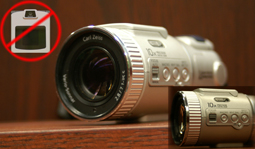Zooming in on compact cameras
- October 24, 2006
- |
- Matt Cook, Technical Editor
- Section: Technology
As mentioned in this week’s column, compact digital cameras flood the photography market with so many varied models it is nearly impossible to cover them all. Rather than fill this article with a brief look at many cameras, a comparison between two company’s compact lines and two higher-scale compacts is presented. Neither choice in the comparison is necessarily better than the other, but knowing about the features and what/how it works best will enable the consumer to purchase the correct camera for his or her needs.
Kodak Easy Share ONE line The Easy Share ONE line consists of two cameras that share the same features – one is six megapixels and the other is four. Both have three-inch rotating displays with touchscreen menus but no viewfinder, and feature 185 MB of usable internal memory, enough for 1500 pictures at low resolution. (Editor’s note: shooting in the highest resolution mode possible is recommended unless the amount of memory restricts that possibility. It is always possible to downsize the photos later but enlarging a small image simply results in grainy, pixelated photos.)
Both models sport German engineered 3x optical zoom Schneider-Kreuznach Varigon lenses that are high-quality. Also featured on the Easy Share ONE is the ability to wirelessly send photos to a computer or printer that has a Kodak wireless card in it. Best of all in the Easy Share ONE line is the pricing: the four-megapixel camera retails for around $199.95, the six-megapixel version for $299.95. For more technical information, go to kodak.com.
Sony DSC-W line The Sony W line consists of four cameras: the W30 six-megapixel, W50 six-megapixel, W70 7.2-megapixel and W100 8.1-megapixel. The W30 and W50 are quite similar except that the W30 comes in light blue, white and silver and has a two-inch screen instead of a 2.5-inch screen. All of the cameras have 3x optical zoom Carl Zeis lenses, another high-quality German-engineered lens. They also feature 2x digital zoom for a total of 6x zoom. The W line cameras have ISO sensitivity up to at least 1000 (ISO is a relative measurement of how sensitive the sensor is to light. Higher numbers work better in lower lighting but are grainier) and can record small MPEG videos. The W line uses Sony’s proprietary Memory Stick DUO for storage.
The Sony DSC-W line (30, 50, 70, 100 respectively) costs $199.95, $229.95, $279.95, to $349.95. More information can be found at sonystyle.com.
Fuji FinePix E900 The Fuji E900 is a nine-megapixel camera that costs between $300 and $500. It features a 4x optical zoom and 7.6x digital zoom for a total of 30.4 zoom. It has fully manual functions in addition to its automatic setting (“manual settings” means that the user can change the ISO, shutter speed and aperture settings for different exposures.) The camera has a two inch LCD screen – a little on the small side – and a glass viewfinder. It has the capability of shooting in RAW mode, a feature rarely seen in compacts. There is virtually no shutter lag on the camera (the delay between when the shutter release is pressed and the actual picture is taken) making it ideal for objects in motion.
The E900 can record MPEG video but file sizes are large and there is no zoom feature. It runs on double-A batteries instead of a larger rechargeable battery specific to the camera. More information can be found at Fujifilm.com.
Nikon Coolpix S6 Marketed as a stylish camera with fun features such as an in-camera slide show, the Coolpix S6 is the latest in the Nikon Coolpix line. The S6 is a six megapixel, 3x optical zoom camera that sports a three-inch LCD screen but no viewfinder. The camera comes with built-in Wi-Fi to send your pictures to your computer or an equipped printer, although set-up can be a little time-consuming. The camera has an on-board help section which might make it appealing for new photo enthusiasts. It does not have a manual mode like the Fuji E900 but it does feature movie and macro modes.
Shutter lag is greater than that of the E900 and therefore less suited for use with objects in motion. Image quality is also less than the E900 and similar cameras, with lower than normal resolution for a six megapixel camera. The camera as a whole is still good, particularly for consumers wanting a stylish, fun camera around $350. More information can be found at nikondigital.com.
